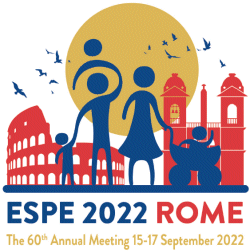
60th Annual ESPE (ESPE 2022)
Rome,
Italy
15 Sep 2022 - 17 Sep 2022
Poster Category 2
GH and IGFs
hrp0095p2-144 | GH and IGFs | ESPE2022
Growpati Study: Clinical and genetic characterization of a cohort of patients with short stature due to severe primary IGF1 deficiency
Stoupa Athanasia , Flechtner Isabelle , Viaud Magali , Pinto Graziella , Samara-Boustani Dinane , Gonzalez-Briceno Laura , Thalassinos Caroline , Amselem Serge , Legendre Marie , Netchine Irene , Brioude Frederic , Polak Michel
hrp0095p2-145 | GH and IGFs | ESPE2022
A user-centred approach to improve digital health solutions in patients requiring growth hormone therapy: Results of a participatory workshop
Alherbish Abdullah , Kaplan Walid , Fernandez-Luque Luis , Rivera-Romero Octavio , Tamer Eladly Farag , Martin O. Savage , Koledova Ekaterina
hrp0095p2-146 | GH and IGFs | ESPE2022
GH responsiveness and IGF1 P2 promotor methylation
Apel Anja , I. Iliev Daniel , Urban Christina , Weber Karin , Schweizer Roland , Blumenstock Gunnar , Pasche Sarah , Nieratschker Vanessa , Binder Gerhard
hrp0095p2-147 | GH and IGFs | ESPE2022
Perception of long-acting growth hormone- data from two surveys in Austria
Belic Jelena , Riedl Stefan , Windisch Manfred
hrp0095p2-148 | GH and IGFs | ESPE2022
Height Velocity in Indonesian Children Receiving Growth Hormone Therapy
B Pulungan Aman , A Andarie Attika , Lestari Pramesti Dwi
hrp0095p2-149 | GH and IGFs | ESPE2022
Advancing personalised medicine for growth hormone delivery: mixed-methods participatory study of a next generation, smart auto-injector device
I Labarta José , Rivera-Romero Octavio , Fernández-Luque Luis , Keiser Matthew , Koledova Ekaterina
hrp0095p2-150 | GH and IGFs | ESPE2022
Alterations in stem cell populations during rIgF-1 (Increlex) therapy in patients with SPIGF1D
Bossowski Artur , Grubczak Kamil , Stożek Karolina , Starosz Aleksandra , Bossowski Filip , Moniuszko Marcin
hrp0095p2-151 | GH and IGFs | ESPE2022
A novel mutation of LHX3 is associated with combined hypopituitarism and dysmorphic face
Noorian Shahab , Savad Shahram , Saffari Fatemeh , Nikkhah Saeed , Talea Ali , Soltani Hedieh
hrp0095p2-152 | GH and IGFs | ESPE2022
IGF1 as reassessment method of GH deficiency in adulthood
Belen Ariza-Jimenez Ana , Antonio Ariza-Jimenez Jose , Jose Martinez-Aedo Ollero Maria , Pedro Lopez-Siguero Juan
hrp0095p2-153 | GH and IGFs | ESPE2022
Avascular necrosis of the hip as a rare complication of growth hormone therapy
van der Linde Annelieke , van Baelen Amber , van Bergen Christiaan
hrp0095p2-154 | GH and IGFs | ESPE2022
Predictive Factors of Adult Height After 2 Years of GH Replacement Therapy in Children with Growth Hormone Deficiency (GHD)
Mastromauro Concetta , Polidori Nella , Gentile Cristina , Chiarelli Francesco , Mohn Angelika , Giannini Cosimo
hrp0095p2-155 | GH and IGFs | ESPE2022
Poor efficacy of growth hormone treatment in a patient with fetal alcohol syndrome
Koga Nobuhiko , Sasaoka Daiki , Tanaka Yukari , Sasaki Fusako , Yatsuga Shuichi , Nagamitsu Shinichiro Nagamitsu Shinichiro
hrp0095p2-156 | GH and IGFs | ESPE2022
Short Term Effects of Growth Hormone in Children and Adolescents with Growth Hormone Deficiency
Tawfik Sameh , Hassan Mona , Attia Mona , Atef Abeer , Mira Marwa , Dowidar Wafaa , Elkhashab Khaled , Diab Wala
hrp0095p2-157 | GH and IGFs | ESPE2022
Prevalence of Childhood Short Stature and weight variations Among Primary School Children
Berrabeh Soumiya , Bouali Houda , Boujtat Khadija , Assarrar Imane , Rouf Siham , Latrech Hanane



